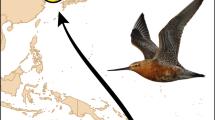Abstract
Synchronous arrival of pairs of migratory birds at their breeding grounds is important for maintaining pair bonds and is achieved by pairs that remain together all year round. Here we show that arrival is also synchronized in paired individuals of a migratory shorebird, the black-tailed godwit (Limosa limosa islandica), even though they winter hundreds of kilometres apart and do not migrate together. The mechanisms required to achieve this synchrony and prevent ‘divorce’ illustrate the complexity of migratory systems.
Similar content being viewed by others
Main
Long-lived migratory birds generally show high degrees of mate fidelity, and divorce is often followed by a decrease in reproductive success1. Synchrony in timing of arrival on the breeding grounds is thought to be crucial for retaining a mate from the previous year and avoiding a costly divorce2,3. In a few species1, pairs both migrate and winter together, so synchronous arrival in spring is inevitable. In many others, one sex departs from the breeding grounds ahead of the other and so the pair migrate separately4; however, their arrival could still be synchronous if they wintered together or were reunited during the spring migration.
The Icelandic black-tailed godwit winters between Britain and Iberia and breeds almost exclusively in Iceland5. About 1.5% of the population is currently individually colour-marked5, and the winter destinations of 55% of these birds have been identified using a large network of volunteer observers. To investigate the arrival patterns of pairs of godwits, we located individuals that had been colour-marked as breeding birds in previous years by twice-weekly searches of 14 study plots on the breeding grounds in southern Iceland, in 2002 and 2003.
Breeding godwits arrived over a one-month period between mid-April and the middle of May. Previously paired males and females arrived within 3.1 (±1.3 s.e., n = 10) days of one another (Fig. 1a). These remarkably synchronous arrival times are not achieved through pairs wintering in the same area and therefore departing together: paired male and female godwits winter, on average, 955 km apart (+165 s.e., n = 14; range, 49–1,946 km; Fig. 1b).
a, The arrival dates (days from 31 March) of paired males and females were highly correlated (r = 0.97, P<0.001); the regression line indicates identical arrival times for males and females. For each pair, data are for one year only. b, Wintering locations of pairs of godwits. Each line links a pair and the circle indicates the female's location. Locations of 12 of the 14 pairs are known in the same winter. Godwits show a very high degree of between-year philopatry in winter.
Neither do the pairs meet during migration: during 1999–2004, we studied migratory flocks upon their arrival in Iceland (before they moved on to the breeding grounds)5,6 and never encountered paired birds in the same flocks, despite locating 15 marked individuals whose mates were known. Arrival synchrony seems to be related to mate retention, however, as the only divorces occurred in two of the three pairs that arrived more than eight days apart (Fig. 1a).
How is this degree of synchrony maintained between pairs when they winter so far apart and the environmental conditions for migration are likely to differ locally? It is possible that pairs of birds may winter in areas of similar quality (despite their geographic separation) and so be in a similar condition to arrive at specific times in spring; or they may share some genetic or physiological determinant of timing of migration; or they may independently synchronize their arrival to the optimal time for each specific breeding location (for example, to exploit peaks in resource abundance). As individuals often use a series of passage sites during spring migration, they may refine these timings as they approach their breeding grounds. Identifying which of these mechanisms is operating is likely to be key to understanding how synchrony is achieved and divorce avoided in migratory species.
References
Ens, B. J., Choudhury, S. & Black, J. M. in Partnerships in Birds: the Study of Monogamy (ed. Black, J. M.) 344–401 (Oxford Univ. Press, Oxford, 1996).
Coulson, J. C. & Thomas, C. S. Proc. Int. Ornithol. Congr. 17, 823–833 (1980).
Handel, C. M. & Gill, R. E. Anim. Behav. 60, 471–481 (2000).
Reynolds, J. D. & Székely, T. Behav. Ecol. 8, 126–134 (1997).
Gunnarsson, T. G. et al. Bird Study (in the press).
Gill, J. A. et al. Nature 412, 436–438 (2001).
Author information
Authors and Affiliations
Corresponding author
Ethics declarations
Competing interests
The authors declare no competing financial interests.
Additional information
brief communications is intended to provide a forum for short, topical reports of general scientific interest and for online technical discussion of recently published material of particular interest to non-specialist readers (brief communications arising). Priority will be given to contributions that have fewer than 500 words, 10 references and one figure. Detailed guidelines are available on Nature's website.
Rights and permissions
About this article
Cite this article
Gunnarsson, T., Gill, J., Sigurbjörnsson, T. et al. Arrival synchrony in migratory birds. Nature 431, 646 (2004). https://doi.org/10.1038/431646a
Published:
Issue Date:
DOI: https://doi.org/10.1038/431646a
This article is cited by
-
Individual consistency in migration strategies of a tropical seabird, the Round Island petrel
Movement Ecology (2022)
-
The influence of social cues on timing of animal migrations
Nature Ecology & Evolution (2022)
-
Pair bonds during the annual cycle of a long-distance migrant, the Arctic Tern (Sterna paradisaea)
Avian Research (2021)
-
Paternal effects in the initiation of migratory behaviour in birds
Scientific Reports (2021)
-
Behavioural plasticity in the early breeding season of pelagic seabirds - a case study of thin-billed prions from two oceans
Movement Ecology (2019)
Comments
By submitting a comment you agree to abide by our Terms and Community Guidelines. If you find something abusive or that does not comply with our terms or guidelines please flag it as inappropriate.




